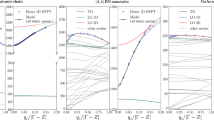Abstract
We investigate the collective mode dispersions for the tight-binding dielectric matrix with two one-dimensional electron bands per donor and acceptor chains, and the three-dimensional long-range Coulomb electron-electron interaction within the random phase approximation. The hybridized collective modes are the result of the strong coupling between the intraband plasmon and the interband dipolar modes due to strong dipole Coulomb interactions. Our calculations show the existence of the low-energy renormalized plasmon mode above the electron-hole quasi-continuum in the long wavelength limit. The obtained modes are brought into correspondence with the optical data of quasi-one-dimensional organic conductor tetrathiafulvalene-tetracyanoquinodimethane (TTF-TCNQ). Namely, the renormalized plasmon and the dipolar mode are assigned to the observed excitations at respective energy scales of roughly 10 meV and 0.75 eV, explaining why lower excitation is eliminated while higher excitation persists below the temperature of the Peierls phase transition.
Similar content being viewed by others
References
B. Sahraoui, I.V. Kityk, P. Hudhomme, A. Gorgues, J. Phys. Chem. B 105, 6295 (2001)
J. J. Ritsko et al., Phys. Rev. Lett. 34, 1330 (1975)
P. F. Williams, A. N. Bloch, Phys. Rev. B 10, 1097 (1974)
P. F. Williams, A. N. Bloch, Phys. Rev. Lett. 36, 64 (1976)
L. M. Khan, J. Ruvalds, Phys. Rev. B17, 4600 (1978)
D. B. Tanner et al., Phys. Rev. B 13, 3381 (1976)
C. S. Jacobsen, In: S. Barišić et al. (Ed.), Leture Notes in Physics 95, (Springer-Verlag, New York, 1979) 223
H. Basistaetal., Phys. Rev. B 42, 4088 (1990)
I. Egri, Phys. Rep. 119, 363 (1985)
P. Županović, A. Bjeliš, S. Barišić, Z. Phys. B 101, 397 (1996)
P. Županović, A. Bjeliš, S. Barišić, Europhys. Lett. 45, 188 (1999)
R. M. Metzger, A. N. Bloch, J. Chem. Phys. 63, 5098 (1975)
A. J. Epstein et al., Phys. Rev. B 13, 1569 (1976)
R. M. Metzger, J. Chem. Phys. 75, 3087 (1981)
L. Cano-Cortés et al., Eur. Phys. J. B 56, 173 (2007)
R. R. Pennelly, C. J. Eckhardt, Chem. Phys. 12, 89 (1976)
D. Jérome, H.J. Schulz, Adv. Phys. 31, 299 (1982)
P. Županović, A. Bjeliš, Ž. Agić, Fizika A (Zagreb) 10, 203 (2001)
A. S. Davydov, Theory of Molecular Excitations (Plenum Press, New York, 1971)
A. J. Berlinsky, J. F. Carolan, L. Weiler, Solid State Comm. 15, 795 (1974)
Author information
Authors and Affiliations
Corresponding author
About this article
Cite this article
Lošić, Ž.B., Županović, P. Collective mode dispersions of organic chain compounds. centr.eur.j.phys. 8, 283–288 (2010). https://doi.org/10.2478/s11534-009-0113-x
Received:
Accepted:
Published:
Issue Date:
DOI: https://doi.org/10.2478/s11534-009-0113-x




